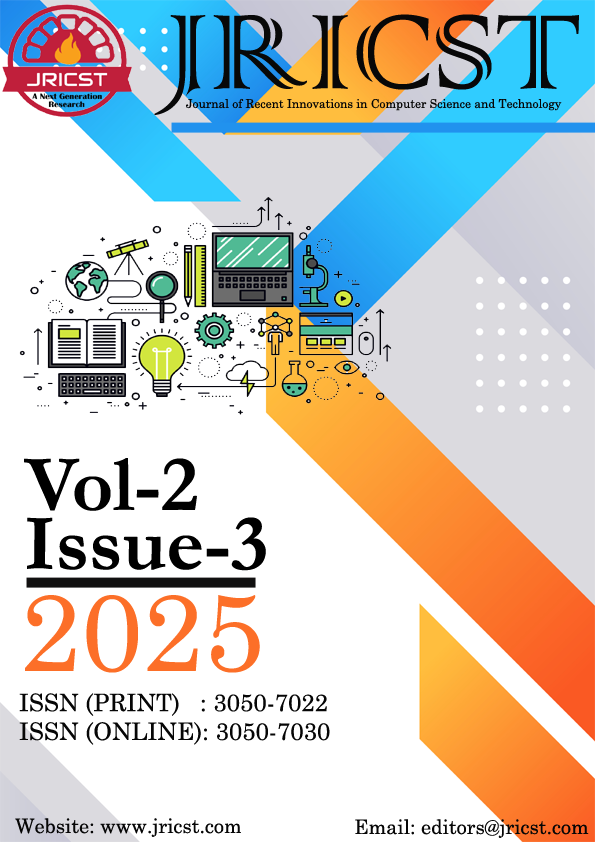Variational Autoencoder Model for Image Processing Methods in Game Design
DOI:
https://doi.org/10.70454/JRICST.2025.20301Keywords:
Variational , Image Processing, Game Design, Deep Learning, Procedural Generation, Latent Representation, Asset Creation, Neural NetworksAbstract
This paper investigates the use of Variational Autoencoders (VAEs) as a deep learning-based generative framework for AI-assisted image processing in game design, focusing on the procedural generation of stylized visual assets. Its application in AI-assisted image generation in game design for the generation of diverse stylized visual assets is explored in this paper. In order to learn stylistic consistent content and generate new art for the Ethereal Monsters game, we propose a deep learning-based generative approach using VAEs to learn latent representations of existing game art. Pre-processing of a curated dataset of 10,000 game sprites spans parsing colour palette and sprite patterns, creating an adapted palette for less sparse variants of sprites, and creating training and testing sets through pooling sprites into images and grouping images for a generation. A convolutional VAE architecture is trained, its (re)construction loss and visual fidelity are evaluated, a prospective error correction test is performed, and the results are analysed. We show that the VAE model can effectively capture the main features of 2D game sprites and if iterated numerous times not only does it produce an endless number of variations, but it also keeps the game-specific aesthetic properties. It is compared with existing generative methods and improved visual coherence is found, whilst diversity is saturated. It adds to the exploration of AI-driven creativity in game design, in particular an increasing number of ways to generate assets and prototypes in a scalable way.
Downloads
References
[1] Akkem, Y., Biswas, S.K. and Varanasi, A., 2024. A comprehensive review of synthetic data generation in smart farming by using variationalautoencoder and generative adversarial network. Engineering Applications of Artificial Intelligence, 131, p.107881.
[2] Girin, L., Leglaive, S., Bie, X., Diard, J., Hueber, T. and Alameda-Pineda, X., 2020. Dynamical variationalautoencoders: A comprehensive review. arXiv preprint arXiv:2008.12595.
[3] Mak, H.W.L., Han, R. and Yin, H.H., 2023. Application of variationalautoEncoder (VAE) model and image processing approaches in game design. Sensors, 23(7), p.3457.
[4 ] Vahdat, A. and Kautz, J., 2020. NVAE: A deep hierarchical variationalautoencoder. Advances in neural information processing systems, 33, pp.19667-19679. Mishra, A., Krishna Reddy, S., Mittal, A. and Murthy, [5] H.A., 2018. A generative model for zero shot learning using conditional variationalautoencoders. In Proceedings of the IEEE conference on computer vision and pattern recognition workshops (pp. 2188-2196).
[6] Innocent, E.K., 2024. Enhancing Data Security in Healthcare with Synthetic Data Generation: An Autoencoder and VariationalAutoencoder Approach (Master's thesis, Oslo Metropolitan University).
[7] Bengesi, S., El-Sayed, H., Sarker, M.K., Houkpati, Y., Irungu, J. and Oladunni, T., 2024. Advancements in Generative AI: A Comprehensive Review of GANs, GPT, Autoencoders, Diffusion Model, and Transformers. IEEe Access.
[8] Elbattah, M.; Loughnane, C.; Guérin, J.-L.; Carette, R.; Cilia, F.; Dequen, G. VariationalAutoencoder for Image-Based Augmentation of Eye-Tracking Data. J. Imaging 2021, 7, 83. https://doi.org/10.3390/jimaging7050083
[9] Di Fan, Y.W., Liu, H., Chen, Y. and Wei, A., Design and Implementation of Unity3D-based Image Compression Coding Gamification Teaching System.
[10] Şen, D., Küçükkaykı, H.T. and Sürer, E., 2021. Automated game mechanics and aesthetics generation using neural style transfer in 2d video games. BilişimTeknolojileriDergisi, 14(3), pp.287-300.
[11] Gan, Z., Chai, X., Zhang, J., Zhang, Y. and Chen, Y., 2020. An effective image compression–encryption scheme based on compressive sensing (CS) and game of life (GOL). Neural Computing and Applications, 32, pp.14113-14141.
[12] Xu, S., Guo, C., Zhu, Y., Liu, G. and Xiong, N., 2023. CNN-VAE: An intelligent text representation algorithm. The Journal of Supercomputing, 79(11), pp.12266-12291.
[13] Akbari, M. and Liang, J., 2018, April. Semi-recurrent CNN-based VAE-GAN for sequential data generation. In 2018 IEEE International Conference on Acoustics, Speech and Signal Processing (ICASSP) (pp. 2321-2325). IEEE.
[14] Metlapalli, A.C., Muthusamy, T. and Battula, B.P., 2020. Classification of Social Media Text Spam Using VAE-CNN and LSTM Model. Ingénierie des Systèmes d Inf., 25(6), pp.747-753.
[15] Liu, J., Yang, G., Li, X., Hao, S., Guan, Y. and Li, Y., 2022. A deep generative model based on CNN-CVAE for wind turbine condition monitoring. Measurement Science and Technology, 34(3), p.035902.
[16] Kim, J.Y. and Cho, S.B., 2021. Deep CNN transferred from VAE and GAN for classifying irritating noise in automobile. Neurocomputing, 452, pp.395-403.
Downloads
Published
Issue
Section
License
Copyright (c) 2025 Riya Sharma, Mr.Kapil Kumar (Author)

This work is licensed under a Creative Commons Attribution 4.0 International License.
This is an Open Access article distributed under the term's of the Creative Common Attribution 4.0 International License permitting all use, distribution, and reproduction in any medium, provided the work is properly cited.






